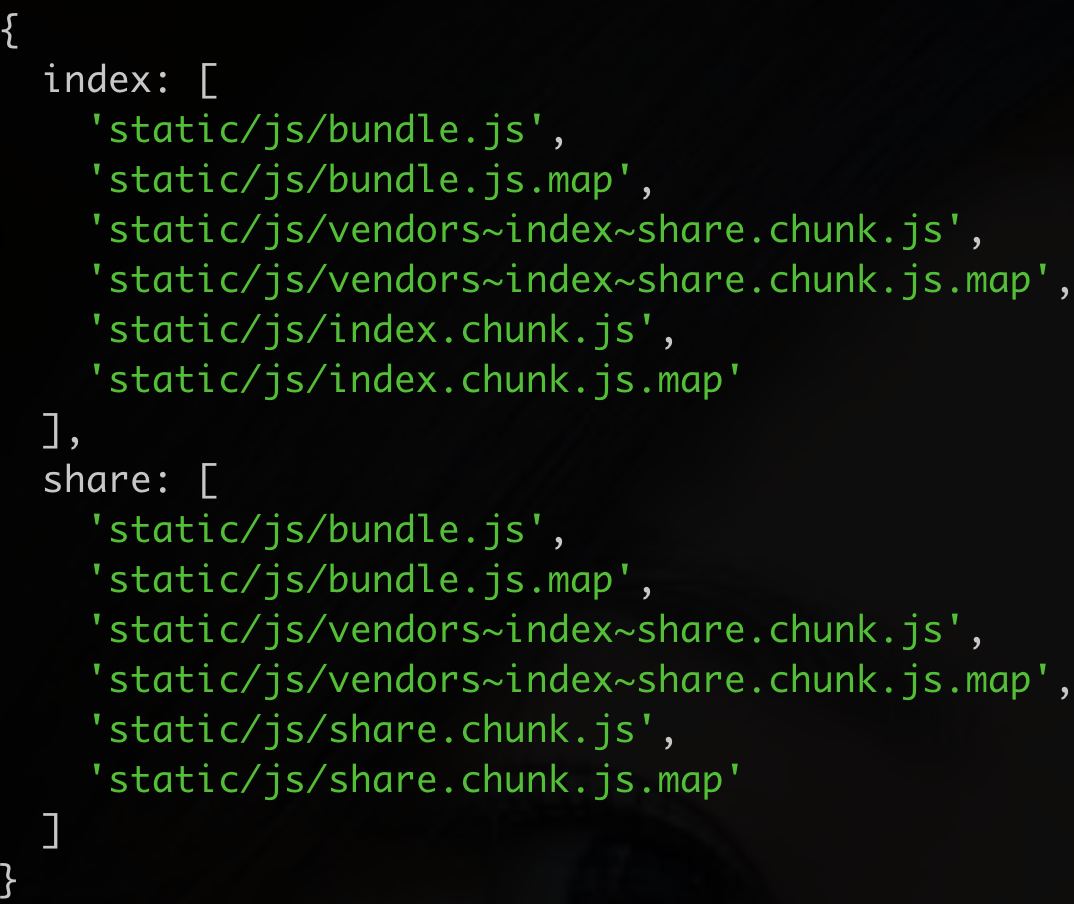现在很多脚手架基本上都是单页面入口的应用,比如 即使是 我已将改造完成的框架放在了GitHub上,您可以直接下载下来进行体验:https://github.com/wenzi0github/create-react-app-mpa。 我们业务的主要特点是: 因此,这里我基于 接下来按照我的步骤,一步步下来,就能顺利的搭建起来了。 我们首先使用 进入到项目 注意,这是一个单项操作,执行后所有的配置就不能再收回去了。 执行后可以看到多了 config 和 scripts 两个文件夹,我们几乎所有的改动都在这两个里面。 不同的版本,在配置上可能稍微有点区别。 sass 的配置是 对于 less,我们就需要自己配置一下,先安装 less 和 less-loader,然后直接参考 sass 的配置即可,在 安装 less: 配置: 这样项目中 sass 和 less 都可以支持了。 在 这里我们添加了 2 个配置,一个是项目打包时的构建目录,一个是构建的入口文件。 在 在多入口的配置上,本地开发和线上发布的是不一样的,这里我们通过变量 isEnvProduction 进行了区分。在本地开发过程中,只能同时启动一个项目,因此会把该项目中所有的页面都作为入口文件;而在发布的过程中,则是通过判断项目是否变动,来进行构建,因此这里没有限定构建项目,而是可以根据变动的项目,产生多个入口。 默认的 entry 和 output 都是固定的,我们要修改为与启动和打包的项目相关。 在 public/index.html 中,我们发现有使用到 我还自己定义了一个变量 然后我在 index.html 中作为 meta 标签来使用: 当然,有些同学喜欢用注释的方式,也是可以的: 我个人在开发中,喜欢使用 然后在 我们可以设置根路径,避免每次都按照相对路径来进行引用。 这里要配置 2 个文件,一个是 config/webpack.config.js,另一个是 tsconfig.json。 config/webpack.config.js: tsconfig.json: 这样就可以通过 有些代码是我们项目中用不到的,这里进行了删除处理,如果您的项目用到的话,那就别删除了。 删除 service worker: 在 webpack.config.js 中有一个关于 的位置。既不报错,也启动不起来。 后来查询了一下,才知道是 我这里呢,是直接删除了,确实没有用到。如果要用的话,应该怎么修改呢? 因此这里修改为: GitHub 上对应的改动 commit:https://github.com/wenzi0github/create-react-app-mpa/commit/16c6de467d8b18faa229b67855cf4014e7988c0a 所有执行的命令,执行文件均放在 安装组件工具 commitlint 和 husky 首先按照 commitlint 组件,我们在上面的 2.2.2 小节已经安装安装了 husky,若没有安装时,这里也要安装下 husky。 执行后,会在项目根目录生成 commitlint.config.js 的配置文件。 然后将 commitlint 添加到 husky 的配置中: 最后我们要添加上我们的规则,这里要修改 首先所有的 commit 信息都要包含下面的关键词: 接着我们要添加自定义规则,约定每个 commit 信息都需要包含 tapid id: 若您还有其他的规则,则接着在 plugins.rules 中继续添加即可。 我们是一个多项目的应用,本地开发时,肯定是要启动一个或几个项目,而不能把所有的项目都启动起来。 这里我们写了一个函数,通过传入的参数,来启动对应的项目。 在 启动时,执行相应的命令即可,例如要启动 demo 项目时: 在流水线中构建时,如何只构建发生变动的项目? 要完成这个功能,需要解决两个问题。 先来说说如何缓存已构建好的构建产物。 只构建发生变动的项目的前提,是 但若解决不了这个问题,则无法只构建当前发生变动的项目,因为下次的发布,会将之前已构建好的项目给顶掉。 否则,您只能每次都得把所有的项目构建一遍。不过这种方式,一是没有必要,再有就是浪费时间。毕竟之前的项目没发生变动。 第 2 个问题是如何判断当前发生变动的项目。 我们公司是通过 Git 网站提供的接口,拿两个 commit id 获取到本地改动的文件,然后判断出哪个项目发生了变动,则构建该项目。若您没有这种条件,还有一种方式是,您当前分支的名称跟您要构建的项目相关,然后构建时,获取这个分支的名称。 当然,您可以根据您公司现有的基础功能来决定采用什么方式。 这里默认您已经有可以缓存构建产物的方式和了。 完成获取所有发生变动项目的函数后,就可以在 在把 终于把教程写完了,在文章里可能有遗漏,或者不太详尽的地方,还请留言,一起探讨。create-react-app等,整个的入口就是src/index.js。Next.js,可以使用next export,导出成一个个单独的 html 页面。但在编译时,依然是全量编译,作为本身是为同构直出量身定制的服务端框架,在导出成纯前端运行的页面时,会多出很多无用的代码。
1. 现状 #
create-react-app进行改造,实现后的功能有:
2. 改造流程 #
2.1 创建项目 #
create-react-app 初始化一个项目。我比较喜欢使用 typescript,因此可以:npx create-react-app my-app --template typescript
#or
yarn create react-app my-app --template typescript
my-app中,因脚手架将配置隐藏了,改造时,需使用npm run eject命令释放出配置。$npm run eject
2.2 添加 sass 和 less #
create-react-app本身已配置好,但还需要自己下载一下sass这个包:$npm i sass --save-dev
#or
$yarn add sass
config/webpack.config.js中。$npm install less less-loader --save-dev
// config/webpack.config.js
// 64行左右
const sassRegex = /\.(scss|sass)$/;
const sassModuleRegex = /\.module\.(scss|sass)$/;
+ const lessRegex = /\.less$/; // 新增less的后缀名
+ const lessModuleRegex = /\.module\.less$/; // 新增less的后缀名
// 538行左右
rules: [
// 紧接着sass的配置
{
test: lessRegex,
exclude: lessModuleRegex,
use: getStyleLoaders(
{
importLoaders: 3,
sourceMap: isEnvProduction
? shouldUseSourceMap
: isEnvDevelopment,
},
'less-loader'
),
sideEffects: true,
},
{
test: lessModuleRegex,
use: getStyleLoaders(
{
importLoaders: 3,
sourceMap: isEnvProduction
? shouldUseSourceMap
: isEnvDevelopment,
modules: {
getLocalIdent: getCSSModuleLocalIdent,
},
},
'less-loader'
),
},
]

2.3 多入口的配置 #
config/paths.js中,有各种的配置,这里我们需要添加几个根据项目目录构建的配置。// config/paths.js
module.exports = {
// build后的目录
appProjectBuild: (project) => {
if (project) {
return resolveApp(`dist/${project.project}`);
}
return resolveApp('dist');
},
// 之前是指定的src/index的文件
// 现在是读取src/pages中的项目的文件名
appProjectIndexJs: (project) => resolveModule(resolveApp, `src/pages/${project.project}/${project.name}`), // 项目的入口文件
};
config/webpack.config.js中的导出,是一个函数,这里是我们主要改造的地方。
postcss-px-to-viewport插件,将 px 转为 vw 单位;2.3.1 设置入口和出口路径 #
// config/webpack.config.js
// 添加第2参数project
module.exports = function (webpackEnv, project) {
/**
* 获取入口
* @param {object} entryPages 当前项目所有的页面
* @returns {object}
*/
const getEntries = (entryPages) => {
if (isEnvProduction) {
return [paths.appProjectIndexJs(entryPages)];
}
const entries = {};
entryPages.forEach((page) => {
entries[page.name] = !shouldUseReactRefresh
? [webpackDevClientEntry, paths.appProjectIndexJs(page)]
: paths.appProjectIndexJs(page);
});
return entries;
};
/**
* 根据页面名称生成htmlplugins
* @param {string[]} pages 项目所有的页面名称
* @returns {any[]}
*/
const getHtmlPlugins = (pages) => {
if (isEnvProduction) {
return [
new HtmlWebpackPlugin(
Object.assign(
{},
{
title: pages.config.title,
inject: true,
template: paths.appHtml,
filename: `${pages.name}.html`,
compiledTime: new Date().toLocaleString(),
projectname: pages.config.project,
minify: {
removeComments: true,
collapseWhitespace: true,
removeRedundantAttributes: true,
useShortDoctype: true,
removeEmptyAttributes: true,
removeStyleLinkTypeAttributes: true,
keepClosingSlash: true,
minifyJS: true,
minifyCSS: true,
minifyURLs: true,
},
},
),
),
];
}
return pages.map((page) => {
return new HtmlWebpackPlugin(
Object.assign(
{},
{
title: page.config.title,
inject: true,
projectname: page.config.project,
template: paths.appHtml,
filename: `${page.name}.html`,
chunks: [page.name],
},
),
);
});
};
return {
entry: getEntries(project),
output: {
path: isEnvProduction ? paths.appProjectBuild(project) : undefined,
},
};
};
htmlWebpackPlugin.options.title的变量,这是使用HtmlWebpackPlugin插件定义的。compiledTime,用来标识该项目的编译时间。<meta name="createtime" content="<%= htmlWebpackPlugin.options.compiledTime %>" />
2.3.2 添加
postcss-px-to-viewport插件 #vw和vh单位,来开发移动端的应用,那么postcss-px-to-viewport插件就是必然要安装的。$npm install postcss-px-to-viewport --save-dev
postcss-loader中的 options.plugins 里添加上这个插件:// config/webpack.config.js
// 读取viewportWidth的配置,这个后面要讲
// 正式环境是按照页面构建的,project表示是一个页面的配置
// 本地环境是按照项目构建的,project是页面的数组集合
const { viewportWidth } = isEnvProduction ? project.config : project[0].config;
const getStyleLoaders = (cssOptions, preProcessor) => {
const loaders = [
// 忽略其他代码
{
loader: require.resolve('postcss-loader'),
options: {
// Necessary for external CSS imports to work
// https://github.com/facebook/create-react-app/issues/2677
ident: 'postcss',
plugins: () => [
require('postcss-flexbugs-fixes'),
require('postcss-preset-env')({
autoprefixer: {
flexbox: 'no-2009',
},
stage: 3,
}),
+ require('postcss-px-to-viewport')({
+ viewportWidth: viewportWidth || 750,
+ unitPrecision: 3,
+ viewportUnit: 'vw',
+ }),
// Adds PostCSS Normalize as the reset css with default options,
// so that it honors browserslist config in package.json
// which in turn let's users customize the target behavior as per their needs.
postcssNormalize(),
],
sourceMap: isEnvProduction ? shouldUseSourceMap : isEnvDevelopment,
},
},
];
// 忽略其他代码
};
2.3.3 设置 alias #
// config/webpack.config.js
// 直接查找resolve.alias的位置
module.exports = function (webpackEnv, project) {
/* 忽略其他代码 */
return {
resolve: {
alias: {
// Support React Native Web
// https://www.smashingmagazine.com/2016/08/a-glimpse-into-the-future-with-react-native-for-web/
'react-native': 'react-native-web',
+ '@': path.resolve(__dirname, '..', 'src'), // 以src目录为起始的根目录
// Allows for better profiling with ReactDevTools
...(isEnvProductionProfile && {
'react-dom$': 'react-dom/profiling',
'scheduler/tracing': 'scheduler/tracing-profiling',
}),
...(modules.webpackAliases || {}),
},
},
};
};
{
"compilerOptions": {
"baseUrl": ".",
"paths": {
"@/*": ["./src/*"]
}
}
}
@来引用了:import api from '@/common/config/api'; // 项目目录/src/common/config/api
2.3.4 删除不必要的代码 #
// Generate a service worker script that will precache, and keep up to date,
// the HTML & assets that are part of the webpack build.
isEnvProduction &&
fs.existsSync(swSrc) &&
new WorkboxWebpackPlugin.InjectManifest({
swSrc,
dontCacheBustURLsMatching: /\.[0-9a-f]{8}\./,
exclude: [/\.map$/, /asset-manifest\.json$/, /LICENSE/],
// Bump up the default maximum size (2mb) that's precached,
// to make lazy-loading failure scenarios less likely.
// See https://github.com/cra-template/pwa/issues/13#issuecomment-722667270
maximumFileSizeToCacheInBytes: 5 * 1024 * 1024,
}),
2.3.5 关于 manifest 的配置 #
ManifestPlugin的配置,这里之前一直没管。每次启动项目时,就会卡在Starting the development server
ManifestPlugin这里配置错了。entrypoints.main开始时,是一个数组,可以执行filter()方法。但修改上面的 webpack 配置后,entrypoints 不再一定包含 main 属性,如图。
let list = [];
// 获取到entrypoints所有的数组
for (const key in entrypoints) {
list = list.concat(entrypoints[key]);
}
// 文件去重,并筛选掉.map结尾的文件
const entrypointFiles = [...new Set(list)].filter((fileName) => !fileName.endsWith('.map'));

2.4 配置命令行 #
scripts目录中,然后在package.json中进行配置。2.4.1 添加 commit 信息的检查 #
#Install commitlint cli and conventional config
npm install --save-dev @commitlint/{config-conventional,cli}
#For Windows:
npm install --save-dev @commitlint/config-conventional @commitlint/cli
#Configure commitlint to use conventional config
echo "module.exports = {extends: ['@commitlint/config-conventional']}" > commitlint.config.js
#Add hook
npx husky add .husky/commit-msg 'npx --no-install commitlint --edit "$1"'
commitlint.config.js文件了。module.exports = {
extends: ['@commitlint/config-conventional'],
rules: {
'type-enum': [
2,
'always',
[
'feat', // 新功能(feature)
'fix', // 修补bug
'docs', // 文档(documentation)
'style', // 格式(不影响代码运行的变动)
'refactor', // 重构(即不是新增功能,也不是修改bug的代码变动)
'test', // 增加测试
'chore', // 构建过程或辅助工具的变动
'revert', // 回滚
],
],
},
};
/* eslint-disable */
module.exports = {
extends: ['@commitlint/config-conventional'],
plugins: [
{
rules: {
'need-tapd': (params) => {
// http://km.oa.com/group/39598/articles/show/440469
// 提交规范的文档:https://iwiki.woa.com/pages/viewpage.action?pageId=172232748
const { subject, body, footer } = params;
const reg = /(--bug=|--story=|--task=|--issue=)(\d+)(\s|$)/;
if (reg.test(subject) || reg.test(body) || reg.test(footer)) {
// 只要任意一个位置包含了tapd的相关信息即可
return [true];
}
// 若没有关联tapd,则返回错误,并进行提示
return [
false,
'should contain --story or --bug or --task or --issue\n' +
'see https://iwiki.woa.com/pages/viewpage.action?pageId=172232748',
];
},
},
},
],
rules: {
'type-enum': [
2,
'always',
[
'feat', // 新功能(feature)
'fix', // 修补bug
'docs', // 文档(documentation)
'style', // 格式(不影响代码运行的变动)
'refactor', // 重构(即不是新增功能,也不是修改bug的代码变动)
'test', // 增加测试
'chore', // 构建过程或辅助工具的变动
'revert', // 回滚
],
],
'need-tapd': [2, 'always'], // 添加上我们的自定义规则
},
};
2.4.2 启动某个单独的项目 #
/* eslint-disable */
const chalk = require('react-dev-utils/chalk');
const glob = require('glob');
const path = require('path');
const getConfigByConfig = require('./getConfig');
const noFileMsg = (project) => `start error, the reason may be:\n
1. project enter error, please ensure you right;
2. in pages/${project} has not .tsx file, at least one .tsx fle\n`;
// 在启动和构建之前执行的代码
// 主要用于检查输入的命令和读取配置文件
// feature-h5/card
const beforeFn = async () => {
const argv = process.argv.slice(2); // 获取传入的参数
const [project] = typeof argv === 'object' && argv.length ? argv : [''];
if (project.length) {
const list = glob.sync(`src/pages/${project}/*.tsx`).filter((item) => !item.includes('test.ts')); // 获取该项目中所有的入口文件
if (list.length === 0) {
// 若该项目没有入口文件,则进行提示
console.log(chalk.red(noFileMsg(project)));
process.exit(1);
}
const ss = list
.map((item) => {
const { ext, name } = path.parse(item);
if (ext === '.tsx') {
const config = getConfigByConfig(`src/pages/${project}/${name}.json`);
return {
name,
project,
config,
src: item,
};
}
return null;
})
.filter(Boolean);
return Promise.resolve(ss);
} else {
// 命令不正确
console.log(chalk.red(`please start like: \`npm run start home\`, or \`npm run start --page home\`\n`));
process.exit(1);
}
};
module.exports = beforeFn;
scripts/start.js中,我们来调用这个 beforeFn 函数,获取要启动的项目:beforeFn()
.then((projects) => {
// project = [
// {
// name: 'index',
// project: 'home',
// src: 'src/pages/home/index.tsx'
// },
// {
// name: 'share',
// project: 'home',
// src: 'src/pages/home/share.tsx'
// }
// ]
startCheckBrowsers(projects);
})
.catch((err) => {
console.log(err);
process.exit(1);
});
$npm run start demo

2.4.3 如何只构建发生变动的项目 #
可以缓存已构建项目的构建产物,然后可以将本次的构建产物与之前的构建产物进行合并。然后一并发到服务器上。无论您是将构建好的 html 发到 cdn 上,还是存储到数据库中,还是其他方式(比如我们内部的蓝盾流水线可以缓存构建产物),都是可以的。script/build.js中调用他了。try {
const entries = await checkFn('npm run build');
let allResult = [];
for (let key in entries) {
const projects = entries[key].projects;
// console.log(projects)
if (projects.length) {
const result = projects.map((item) => {
return startCheckBrowser(item);
});
allResult = allResult.concat(result);
Promise.all(result).then(() => {
console.log(`${projects[0].project} all builded`);
console.log(`>> step 2: ${projects[0].project} has been builded`);
});
}
}
await Promise.all(allResult);
console.log(chalk.green(`>> step 3: all pages files builded success`));
console.log('>> step 4: starting upload static files');
// 构建完成后,则上传静态资源
uploadStatic();
console.log(`>> step 4.6: all files upload success`);
} catch (err) {
console.log(err);
process.exit(1);
}
3. 总结 #
create-react-app改造成多页面的应用过程中,最重要的是对 webpack 配置的改造。
版权属于:
加速器之家
作品采用:
《
署名-非商业性使用-相同方式共享 4.0 国际 (CC BY-NC-SA 4.0)
》许可协议授权

评论